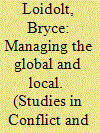|
|
|
Sort Order |
|
|
|
Items / Page
|
|
|
|
|
|
|
| Srl | Item |
| 1 |
ID:
106612


|
|
|
|
|
| Publication |
2011.
|
| Summary/Abstract |
Al Qaeda and allied groups continue to pose a threat to the United States. Although it is less severe than the catastrophic proportions of a 9/11-like attack, the threat today is more complex and more diverse than at any time over the past nine years. Al Qaeda or its allies continue to have the capacity to kill dozens, or even hundreds, of Americans in a single attack. A key shift in the past couple of years is the increasingly prominent role in planning and operations that U.S. citizens and residents have played in the leadership of Al Qaeda and aligned groups, and the higher numbers of Americans attaching themselves to these groups. Another development is the increasing diversification of the types of U.S.-based jihadist militants, and the groups with which those militants have affiliated. Indeed, these jihadists do not fit any particular ethnic, economic, educational, or social profile. Al Qaeda's ideological influence on other jihadist groups is on the rise in South Asia and has continued to extend into countries like Yemen and Somalia; Al Qaeda's top leaders are still at large, and American overreactions to even unsuccessful terrorist attacks arguably have played, however inadvertently, into the hands of the jihadists. Working against Al Qaeda and allied groups are the ramped-up campaign of drone attacks in Pakistan, increasingly negative Pakistani attitudes and actions against the militants based on their territory, which are mirrored by increasingly hostile attitudes toward Al Qaeda and allied groups in the Muslim world in general, and the fact that erstwhile militant allies have now also turned against Al Qaeda. This article is based on interviews with a wide range of senior U.S. counterterrorism officials at both the federal and local levels, and embracing the policy, intelligence, and law enforcement communities, supplemented by the authors' own research.
|
|
|
|
|
|
|
|
|
|
|
|
|
|
|
|
| 2 |
ID:
106614


|
|
|
|
|
| Publication |
2011.
|
| Summary/Abstract |
Al Qaeda has developed a coherent strategy for insurgent violence that has much in common with the focoism advocated by Che Guevara in the 1960s. In their strategic writing, explored here, key Islamist strategists stress the role of violence in creating revolution, and describe the export of committed fighters to focoist enclaves at the margins of enemy control. In contrast to some prominent themes in recent scholarship, the article argues that physical space is demonstrably important to the revolutionaries, that their development of leaderless jihad is designed to supplement not replace territorial control, and that their violence is avowedly strategic.
|
|
|
|
|
|
|
|
|
|
|
|
|
|
|
|
| 3 |
ID:
106613


|
|
|
|
|
| Publication |
2011.
|
| Summary/Abstract |
On 29 October 2010, authorities in the United Kingdom and the United Arab Emirates intercepted explosive packages that had been placed on U.S.-bound planes. Less than a year earlier, Umar Farouq Abdulmutallab attempted to detonate explosives aboard Northwest Flight 253. These attacks originated and were organized in Yemen under the supervision of a local Al Qaeda affiliate known as Al Qaeda in the Arabian Peninsula. These attacks are a manifestation of the group's growing international ambitions, yet little scholarship on Al Qaeda explores how affiliates with robust ties to Al Qaeda leadership in Pakistan balance their dedication to global and local jihad(s). This article contends that despite its strong ties to Al Qaeda Central and international posture, Al Qaeda in the Arabian Peninsula still must maintain local relevance and support. Its ability to do so carries implications for counterterrorism policymakers and the broader Al Qaeda movement.
|
|
|
|
|
|
|
|
|
|
|
|
|
|
|
|
| 4 |
ID:
106615


|
|
|
|
|
| Publication |
2011.
|
| Summary/Abstract |
This article explores the consequences for the funding of Islamist terrorist groups of nationalization, in the form of state sponsorship, versus privatization, in the form of autonomous financing. The article begins by examining the evolution in terrorist groups' sources of funding from state sponsorship to autonomous activity, then turns to the benefits and costs to terrorist groups of relying on state sponsors. The article then analyzes the benefits and costs of procuring funding autonomously. Finally, the article weighs those benefits and costs in relation to a terrorist group's emphasis on enhancing its constituency versus pursuing its agenda. The article's central conclusion is that nationalization tends to boost a terrorist group's constituency while privatization tends to bolster a group's agenda. Determining which advantage takes priority depends on the relative importance to a given terrorist group at a particular time of enhancing its constituency versus advancing its agenda.
|
|
|
|
|
|
|
|
|
|
|
|
|
|
|
|
|
|
|
|
|